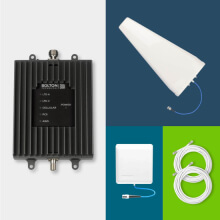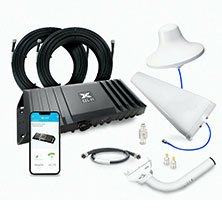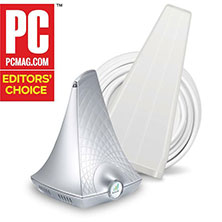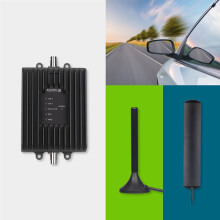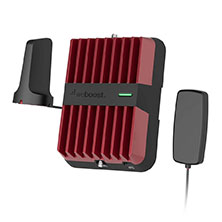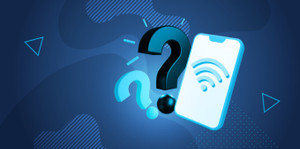What Are the Differences Between a 4G and a 5G Tower?
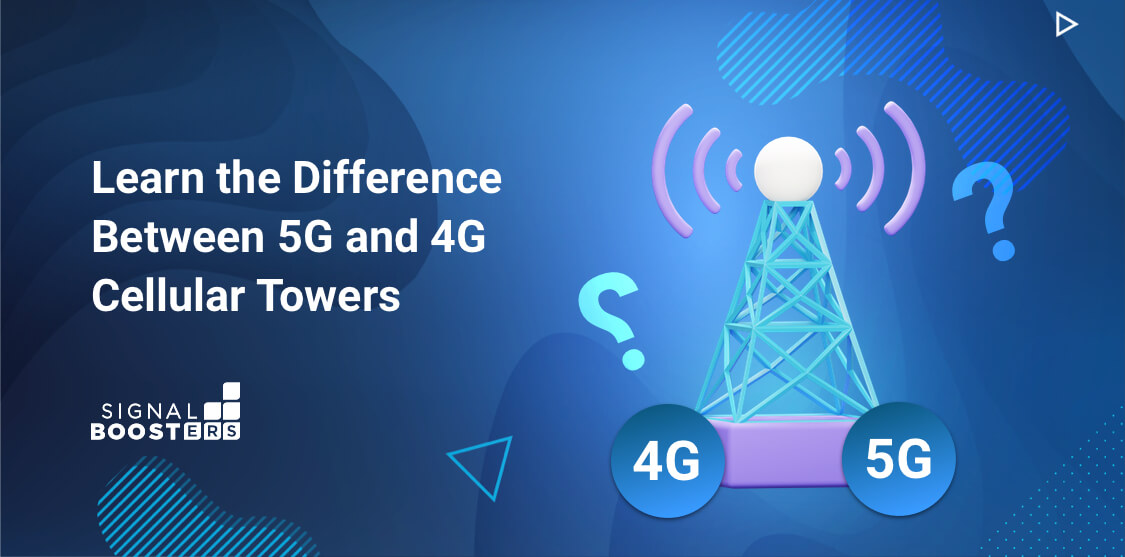
Cellular networks are the most common way of staying connected in the world. Even in areas where the signal is weak, you can use a cell phone signal booster to get more bars.
5G is the latest form of cellular technology. Working in tandem with existing 4G, it provides faster data while 4G covers larger distances and allows for voice and text.
4G towers cover the globe already and in between them you can begin to see 5G towers popping up. So far these are mostly found in urban areas, but we will start to see them all over as technology develops. But what are the differences between them? How do you know if you have a 5G tower near you?
Take advantage of our system design and installation services. Learn more or call us for a free consultation: 1-800-969-8189.
What Do 5G and 4G Towers Look Like?
5G towers tend to be smaller than their 4G counterparts. You’ll find them placed closer together than 4G towers, about 500 to 1000 ft apart. They make use of different hardware called small-cell technology.
5G towers or masts broadcast high bandwidth millimeter wave (mm-Wave) frequencies that allow for high-speed data transfers. Shortly we will begin to see them broadcasting on the so-called goldilocks spectrums of the C-band as well, delivering both speed and distance. Either way, the hardware and aesthetics of the 5G tower will remain the same.
The antennas and panels on a 5G tower are much smaller than their 4G counterparts. They can often be mounted on utility poles and don’t need massive purpose-built masts. The actual hardware to broadcast 5G is just a small box and can be mounted anywhere. When you travel around the city, keep an eye out for discreet boxes mounted on lamp posts or other utility poles.
4G towers are the big generic cell phone towers that you see all over the country. In the city, their hardware could be mounted in buildings, or on large masts. Big metal frames bristling with antennas and dishes are difficult to hide, so are often designed to look like trees. When 4G towers were first erected many had trees panted around them to camouflage them somewhat. The trees of course then grew and ended up blocking the cell signal from the very towers they were planted to hide. 4G towers can of course be kitted out with 5G hardware as well.
How Many 5G Towers Will There Be?
5G is a higher frequency network than 4G. It is faster, but the signal doesn't travel as far. To combat this, we need more 5G towers per area. Although the number of towers per square mile is higher, they are smaller, and their hardware supports as many functions and standards as possible. This means that they will need less upgrading in the future. You may not even notice when a 5G tower goes up in your neighborhood. They are designed to blend into the surrounding area, providing fast stable connection without intruding on your life.
The exception to the rule when it comes to 5G towers is T-Mobile's 5G. They use Extended Range 5G, which works on a lower frequency. Because of this, they are simply repurposing their towers from 4G to 5G, without having to add extra 5G masts.
Why are 5G Towers So Small?
5G works with something called small-cell technology. These so-called small cells are little radio transceivers that send and receive radio signals on a very high frequency. They need very little power to run and can be installed in all sorts of places. Think of a small-holed mesh, providing blanket coverage with lots and lots of little nodes, instead of a big web with only a few large towers. The smaller mesh can transfer data faster as there are more towers.
Each of these small cell towers has antennas and carrier-specific radios inside them. These little radio receivers are connected via fiber, wired, or microwave backhaul. These small cell radios can connect with both 5G and 4G devices, using a range of frequencies. These small cell towers can cover between 30 to 8,000 ft. These small cells are important because together they form a network that can carry more traffic at a faster speed than the older 4G network.
Are 5G Towers Dangerous?
No. 5G is not dangerous at all. It’s just the newest generation of cellular technology. The G in 4G and 5G stands for “generation”. 1G came into existence as long ago as the early 1980s, although it could only transfer voice and not data. 2G gave us some data transfer and was the official birth of the smartphone revolution.
Cellular wireless technology has been around us for almost half a century. The FDA has done numerous tests and conducted lots of research to find out if the RF (radiofrequency) radiation that they give off is harmful. As for 5G, most of the frequencies that are used for it have been used in the past for other things. Therefore, if 5G is dangerous, then we have already been using those so-called dangerous frequencies for a long time, and we should have been seeing the effects of it ages ago.
Use One of These Home Cell Signal Boosters For Better Reception
Best Home Signal Booster Kits
Bolton Victory Yagi/Panel Cellular Signal Booster
Overview of the Bolton Victory Yagi/Panel:
- For Small to Medium Size Homes and Offices
- Covers Up to 4,000 Sq Ft
- Up to +72 dB Gain
- Up to 26 dBm Uplink Power
- Supports All Carriers Simultaneously
The Bolton Victory Yagi/Panel cellular booster is our top pick for rural areas. Under optimal conditions, it can blanket up to 4,000 sq ft with stronger cell reception, which is more than enough for most people. Featuring up to 26 dBm uplink and up to 72 dB gain, it has incredible reach and can significantly amplify your existing weak cellular signal.
Strategically paired with the Bolton Quicksilver Outdoor Yagi Antenna, it works wonders in remote locations. This antenna is designed to draw in signals from cell towers up to 5 miles away. Distance from the signal source will no longer be a problem.
While capable of boosting multiple carriers at the same time, you may only receive improved cell reception from one or two carriers. This is because the antenna is directional and needs to point at the closest cell tower that’s powered by your preferred carrier. If boosting multiple carriers is more important than coverage area, consider the Bolton Velocity Omni/Panel Cellular Signal Booster.
| Pros: | Cons: |
|
|
Cel-Fi by Nextivity GO X Cell Signal Booster
Overview of the Cel-Fi GO X:
- For Large Homes and Offices
- Covers Up to 15,000 Sq Ft
- Up to +100 dB Gain
- Amplifies One Carrier at a Time
The GO X by Nextivity is the most powerful cell phone signal booster for remote areas available. It’s designed with up to 100 dB gain, the highest on the market. This unit can seriously make all your signal woes disappear. The caveat is that it can only boost one carrier at a time. Though, through the Cel-Fi WAVE app, you’re able to switch between carriers as you need.
Super customizable, you have multiple outdoor antenna options to really maximize the amplifier's reach to your closest cell tower. You can reach cell towers located up to 5 miles away with the Quicksilver Yagi, up to 10 miles away with the Bolton Arrow LPDA, or up to 20 miles away with the Bolton Long Ranger. No matter how weak your cellular reception is, any of these configurations will keep you connected, that is unless you’re in a total dead zone.
Rated to cover up to 15,000 sq ft, it's best for large homes and small businesses. Indoor coverage will vary based on the strength of your outside signal.
| Pros: | Cons: |
|
|
SureCall Flare 3.0 Cell Signal Booster
Overview of SureCall Flare 3.0:
- For Small Homes or Spot Coverage
- Covers Up to 3,000 Sq Ft
- Up to +72 dB Gain
- Up to 26 dBm Uplink
- Supports All Carriers Simultaneously
- 2-in-1 Amplifier/Indoor Antenna Combo for Ease of Installation
The SureCall Flare 3.0 cellular booster packs a signal punch for the price. It includes a Yagi antenna, which is ideal for rural areas, and a sleek amplifier. The indoor antenna is built into the amplifier, making the Flare 3.0 one of the easiest units to install yourself.
With up to 72 dB gain and 26 dBm uplink, it offers good amplification and reach to distant cell towers for a booster of its kind. While power is similar to that of the Bolton Victory, the Flare 3.0 offers less coverage and a less powerful Yagi antenna. It’s rated to cover 3,000 sq ft, but will likely only provide multi-room to spot coverage.
| Pros: | Cons: |
|
|
Best Vehicle Cell Signal Booster Kits
Bolton Velocity Vehicle Cell Signal Booster Kit
Overview of the Velocity Vehicle:
- For Cars, Trucks, and RVs
- Up to 50 dB Gain
- Support Multiple Carriers Simultaneously
- Easy Install
The Velocity Vehicle is carefully crafted to keep drivers and passengers connected in the most difficult environments. It’s built with the highest gain and uplink. No matter where you drive, as long as there is a sliver of cellular signal, the Velocity Vehicle will keep all devices connected.
This particular model comes with a magnet mount antenna, making it ideal for your everyday cars, SUVs, and trucks. Installation is a breeze. For semis and heavier-duty trucks, consider the Velocity Trucker. It includes a tough OTR outside antenna featuring great reach, heavy-duty construction, and whistle-free wrap.
| Pros: | Cons: |
|
|
weBoost Drive Reach Cell Signal Booster Kit
Overview of the weBoost Drive Reach:
- For RVs, Cars, Trucks, and Boats
- Up to 50 dB Gain
- Support Multiple Carriers Simultaneously
- Easy Install
The weBoost Drive Reach is weBoost’s most powerful in-vehicle cell signal booster for cars, SUVs, trucks, and minivans. Features increased uplink than previous generations, users can get signal that is 2x farther from towers for twice the signal strength. Dropping calls and losing navigation connection will all be a thing of the past while driving on remote roads or highways.
Cellular antennas will vary depending on the Drive Reach configuration that best meets your needs.
We wouldn't recommend anything weaker than the Drive Reach for rural areas.
| Pros: | Cons: |
|
|
How To Tell The Difference Between A 4G And A 5G Tower
Simply put, 4G towers are the big masts with lots of antennas that you can find all over the country. 5G towers are discreet boxes, often mounted on utility poles. There are many more 5G towers than there are 4G, usually in urban areas. The 5G network is expanding, however, and you can expect to find them in suburban and eventually rural areas soon.
If you need info on anything 5G, 4G, LTE, cellular, how to boost your cell signal, or even just want to chat about anything signal related we can't wait to hear from you! Give us a shout on 1-800-470-6777 or email sales@signalboosters.com.
Interested in Learning More? Check Out Our Cellular Info Hub / WiFi Info Hub


